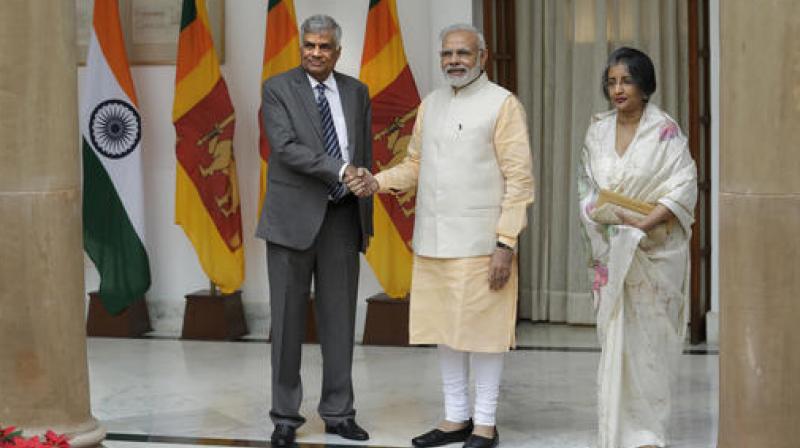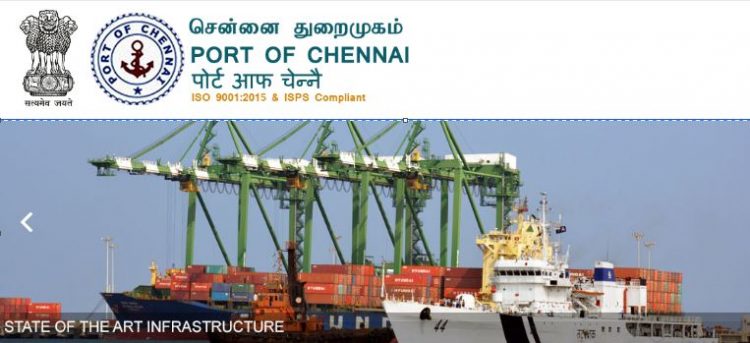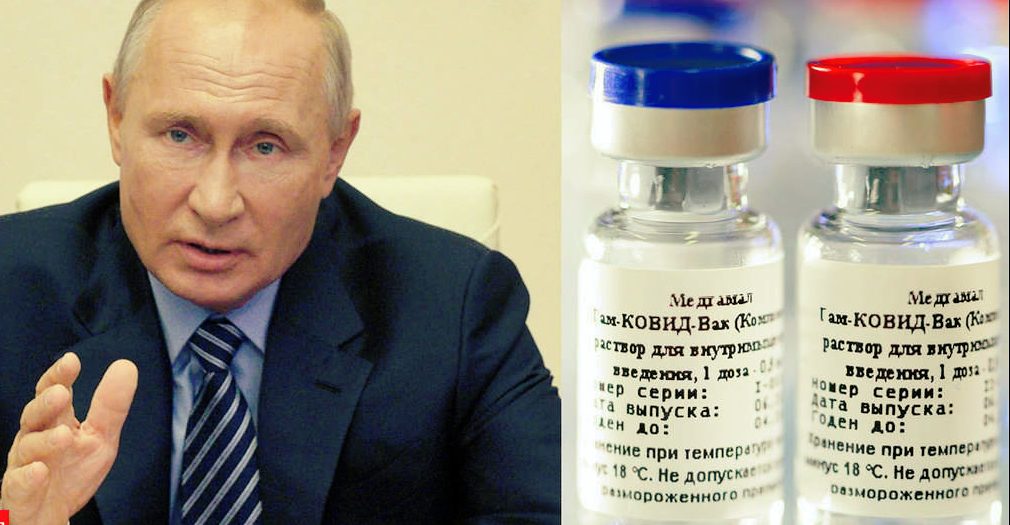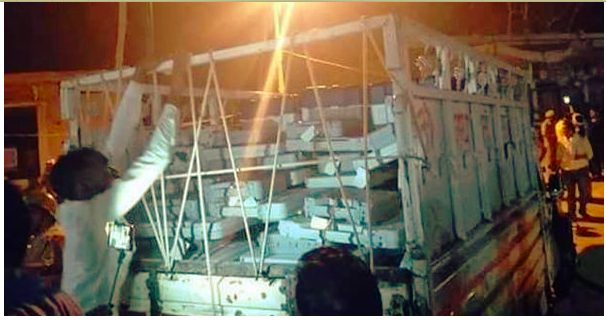After demise of Former Prime Minister Atal Bihari Vajpayee at the age of 93 ., Srilankan Prime Minister Ranil Wickremesinghe Wickremesinghe made these comments after visiting the Indian High Commission on 19th august 2018 here to sign a condolence book for Vajpayee
“Atal Bihari Vajpayee was a “true friend” of Sri Lanka and had assisted the country in the civil war against the LTTE, Prime Minister Ranil Wickremesinghe said
“He was one of the great prime ministers. He was a true friend of Sri Lanka, he stood for Sri Lanka at all times,” Wickremesinghe said.
“When I was the prime minister of Sri Lanka previously, the LTTE was in a very strong position. Our economy was weak. Mr Vajpayee helped us develop the economy and extended military training. We were able to stop the sea Tigers (LTTE’s sea wing) because of him,” Wickremesinghe said.
Wickremesinghe said he met Vajpayee for the first time in 1975. When Vajpayee later became India’s foreign minister in 1977, Wickremesinghe as Sri Lanka’s deputy foreign minister carried on the friendship, he said.
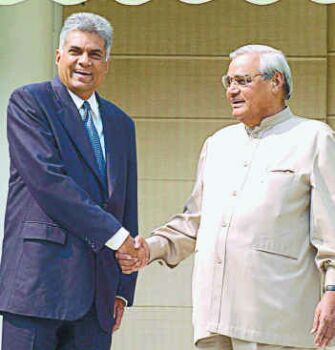
“He gave me his personal telephone number when he returned as the prime minsiter, and we continued the friendship,” Wickremesinghe said.
The nearly three-decades long civil war in Sri Lanka ended in 2009 with the defeat of Liberation Tigers of Tamil Eelam (LTTE).
For those who want to know how prabhakaran has ruined himself a write up of Colonel R. Hariharan is a retired Military Intelligence specialist on South Asia and served as the head of intelligence of the Indian Peace Keeping Force in Sri Lanka 1987-90 reproduced
The LTTE demonstrated its prowess with a daring suicide attack on Colombo’s Katunayake international airport, destroying 26 military and civil aircraft, in July 2001, just four months before Al Qaeda’s dramatic 9/11 attacks in New York. It sent a strong message to Sri Lanka and the world at large that the LTTE was a formidable force not be trifled with. But the consequences of the 9/11 attack on the global attitude to terrorism was far-reaching. The U.S. marshalled forces for a global war on terror to destroy Al Qaeda and its roots in Islamist terror. And the LTTE was already listed in the U.S. as a foreign terrorist organisation.
The late Anton Balasingham, a close confidant of Prabakaran’s and the political adviser to the LTTE, apparently understood the need to modify the LTTE strategy in the face of the rising tide against terrorism. He persuaded a reluctant Prabakaran to agree to take part in a Norwegian-mediated peace process, deferring the idea of an independent Eelam in favour of finding a solution to accommodate Tamil aspirations within a federal structure. That was how the 2002 peace process came into being.
The LTTE signed the Cease Fire Agreement (CFA) with Sri Lanka in 2002 as part of the peace process from a position of political and military strength, having weathered four wars – three against Sri Lankan security forces and one against Indian forces. It was at the pinnacle of its power at that time. To a certain extent, this enabled the Tamil Tigers to dictate the terms of the peace process, which recognised it as the sole representative of the Tamil minority, a status denied to it earlier. Thus, the peace process accorded parity of status to the LTTE at the negotiating table in its equation with the elected government of Sri Lanka.
By then, the repeated stories of LTTE successes, propagated by its well-oiled propaganda machine that glossed over its significant failures (for example, the retaking of control of Jaffna by the Sri Lanka Army), reinforced the popular belief of Prabakaran’s invincibility in war. It also generated great political expectations among the Tamil population of his ability to satisfy their long-standing aspirations through the peace process although he had dropped the demand for an independent Tamil Eelam. All that has been proved wrong now.
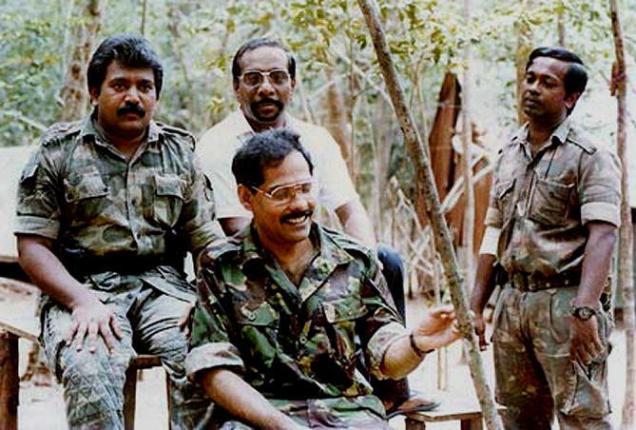
Winston Churchill once remarked, “Those who can win a war well can rarely make a good peace and those who could make a good peace would never have won the war.” This is very true in the case of Prabakaran’s handling of events leading up to the war. His monolithic and egocentric leadership style does not encourage the free exchange of ideas except with his trusted childhood friends. This has been the big roadblock in his strategic decision-making process. Prabakaran failed to use fruitfully the political talent at his disposal, among the seasoned members of the Tamil National Alliance (TNA), in handling complex political issues during the period of peace. Their advice was neither sought nor paid heed to in taking decisions on key issues. The LTTE’s handling of the presidential poll of 2005 is one such instance when their plea for his support to elect Ranil Wickremesinghe, an architect of the peace process, went unheeded.
Wickremesinghe’s rival, Mahinda Rajapaksa, had promised, in his election manifesto, to eliminate LTTE terrorism. Prabakaran not only ignored this but, on the basis of some convoluted reasoning, enforced a boycott of the presidential poll in areas under LTTE control. This action prevented a bulk of the Tamils from voting for Wickremesinghe. This enabled Rajapaksa’s victory with a wafer-thin majority through southern Sinhala votes. And the newly elected President went about systematically dismantling the LTTE.
Similarly, Prabakaran’s handling of the international community lacked coherence. Apparently, he misunderstood the international involvement in the 2002 peace process and thought it was a vindication of the LTTE’s methods. Perhaps this made him complacent when it came to observing the ceasefire in spirit. The LTTE’s conduct, which was in utter disregard of international norms on human rights and humanitarian laws during the entire period of the ceasefire, came under severe criticism from international watchdog bodies and the United Nations. These related to a large number of issues, including the recruitment of child soldiers, illegal arrests and kidnapping apart from the assassinations and suicide bombings. This made the LTTE’s rhetoric on human rights hollow.
While the co-chairs were sympathetic to the Tamil struggle for equity, they were wary of the LTTE’s tactics and covert operations in their own countries. And the LTTE’s indifference to their counsel during the peace process eroded its credibility. Things came to a boil with the assassination of Sri Lankan Foreign Minister Lakshman Kadirgamar in August 2005. This wanton act compelled the European Union and Canada to ban the LTTE. Thus, the LTTE shot itself in the foot as it was banned in 32 countries. The ban also coincided with the introduction of strong international protocols in shipping and against money laundering to prevent the international operations of terrorists.
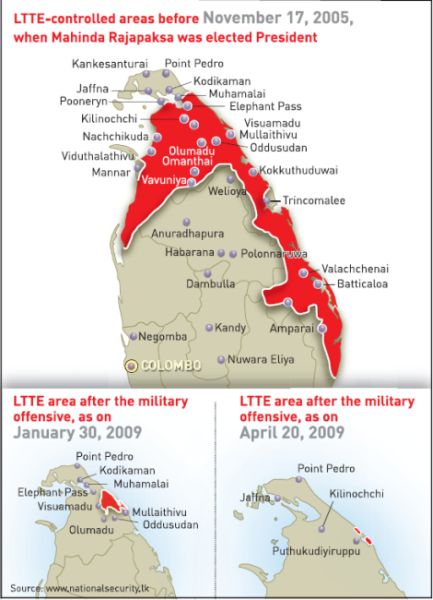
Prabakaran probably failed to appreciate the implications of these developments when he gave the government a legitimate excuse to abandon the peace process after the LTTE made an abortive suicide attack in April 2006 on Lieutenant General Sarath Fonseka, the Army chief. It also enabled Rajapaksa to persuade the international community to crack down on the LTTE’s support network and front organisations in their midst. International cooperation was further enlarged in scope to intelligence sharing and economic aid, which indirectly underwrote Sri Lanka’s mounting burden of war.
Similarly, Prabakaran never made any effort before the war to redeem the LTTE’s relations with India. He failed to tap the fund of sympathy for the Tamil cause that exists in India even among large sections of the non-Tamil population. Presumably, his dubious role in Rajiv Gandhi’s assassination prevented him from dispassionately examining the positive contribution India could have made in pushing the Tamil cause at the negotiating table. Apparently, he put his faith in the international community rather than in India to bail him out when the Sri Lankan government decided to go to war. This showed a lack of understanding of the complexities of international relations. On the other hand, successive Sri Lankan Presidents went out of their way to keep India in good humour and that helped the country politically and militarily in its war with the LTTE. In Eelam War III (1995-2002), the performance of the Sri Lankan security forces was far from satisfactory. By then, the LTTE had developed the Sea Tiger wing – a daring guerilla navy that played havoc with the Sri Lanka Navy. The Sri Lanka Army had suffered heavy casualties in defending Mullaithivu and suffered a huge setback in Elephant Pass despite its superior strength and firepower. In that operation, the LTTE acquired its modern artillery, armour and high-tech communication systems apart from capturing equipment.
At the start of the peace process, the security forces were a demoralised lot. The terms of the peace process further added to their misery as it prevented them from retaliating when the LTTE’s pistol groups systematically eliminated the forces’ intelligence operatives and killed even military commanders during the first three years of peace. In this backdrop, no one was sure of the ability of Sri Lanka’s forces to sustain an offensive against the LTTE when Eelam War IV started in 2006.
Even after the LTTE defeat in Mavil Aru in the Eastern Province in July 2006, the security forces were cautious in their optimism. However, the LTTE belied the defence analysts’ expectations when it floundered in the Eastern Province, offering stiff resistance only in patches. Perhaps, it was at this time that Rajapaksa and Fonseka made up their minds to go the whole hog against the LTTE in the north.
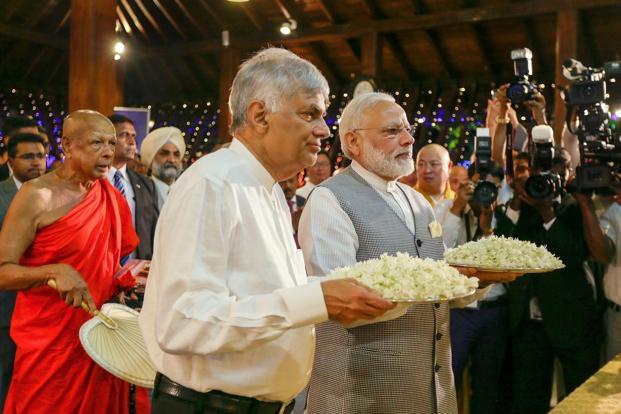
Although Prabakaran has demonstrated strategic military capability in the past, he appears to have failed to draw two obvious strategic deductions in the developing war scenario, which put the LTTE at a disadvantage. The first was not factoring the impact of the defection of Karuna, his able military commander from Batticaloa, on the LTTE’s overall military capability. The second was in underestimating the determination of Sri Lanka’s political and military leadership to turn Rajapaksa’s promise to eliminate the LTTE into a reality.
In the course of time, recruitment from the east to augment LTTE strength petered out. Ultimately, when the security forces launched their offensive in the north with huge numerical superiority, the LTTE did not have the essential strength to face the onslaught. It was clear that the LTTE would not be able halt the security forces by conventional warfare.
However, somehow Prabakaran failed to use his superior insurgency tactics to overcome his limitations in conventional warfare. Instead, the LTTE adopted a passive defensive strategy with a line of bunds that reduced the natural advantage of guerilla mobility enjoyed by the cadre. The bunds imposed a limited delay as they required heavy firepower to break up the offensive. This was a luxury that the LTTE did not enjoy.
The second aspect was the LTTE leader’s failure to read the mind of Rajapaksa. In his first two years in office, the President had oriented his entire policy framework towards the goal of eliminating the LTTE. His strong support to the operations of the security forces, regardless of national and international compulsions, enabled the Army chief to plan and execute his offensive.
Prabakaran never made any effort to patch up with Karuna, who had grievances with respect to the poor representation of easterners in the leadership although they provided the bulk of the LTTE cadre. Instead, he dispatched killers to eliminate Karuna. The rebel leader commanded wide support among cadre in the east, particularly around LTTE strongholds in Batticaloa. A direct consequence of his defection was the disbanding of a bulk of LTTE cadre, other than Karuna’s core supporters. It also drove Karuna into the arms of the Sri Lanka Army for protection. So when the war started in the east, the LTTE’s strength as well as its manoeuvring space was reduced.
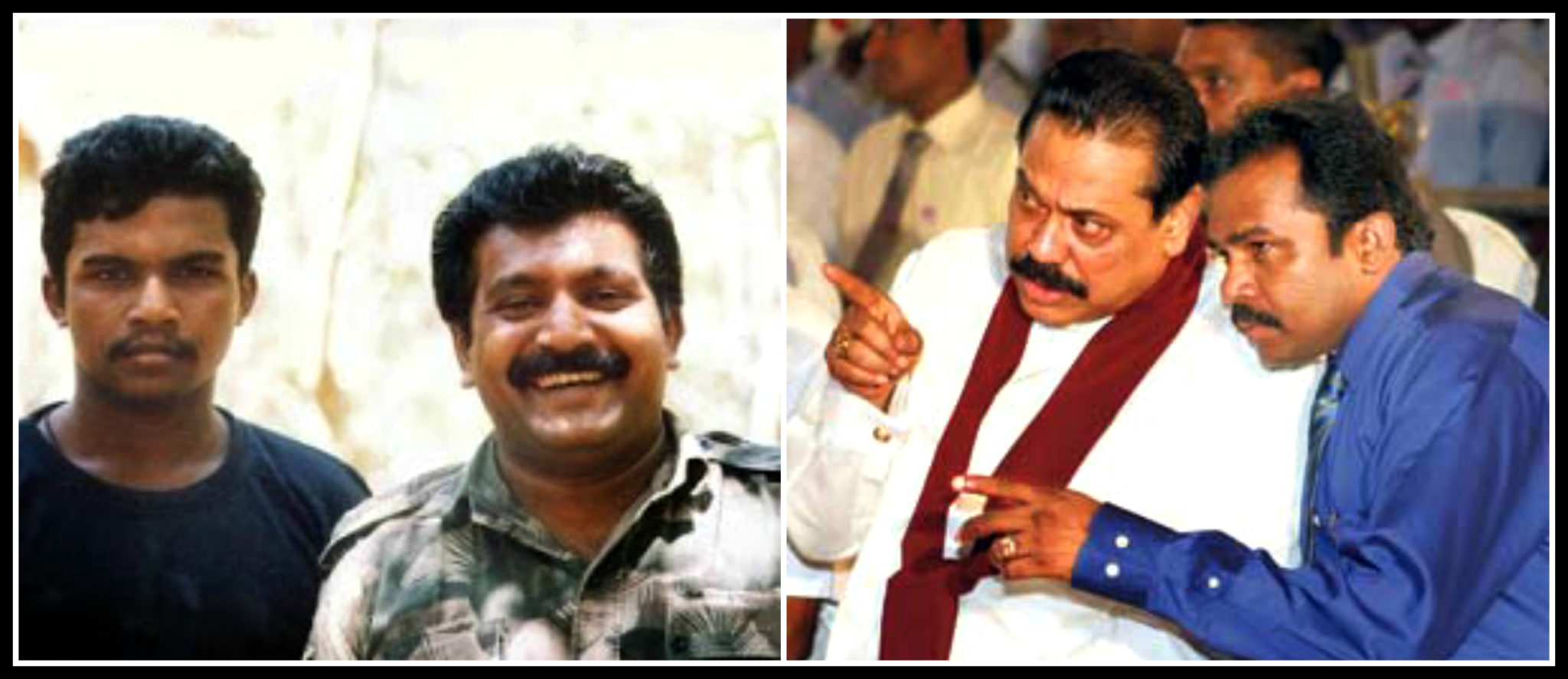
Prabakaran failed to take into account the impact of Karuna’s defection from the LTTE on its overall military capability.
His strategic direction of war, operational planning and neat execution undoubtedly paved the way for success. In the words of Lieutenant General Satish Nambiar, the distinguished Indian Army officer, Fonseka “displayed the qualities of a great military leader nations are blessed with from time to time”. In short, under Fonseka’s leadership, the demoralised armed forces reinvented themselves to become a well-knit and highly motivated force.
As a result, when the security forces went to war in 2006, they were well-trained and enjoyed superiority in firepower and mobility. Learning from the past, they built up force levels on land, in the air and at sea to ensure success against the Tamil Tigers. The Sri Lanka Army went on a recruiting spree. For instance, in the year 2008 alone 40,000 troops were added, to raise 47 infantry battalions, 13 brigades, four task force contingents and two divisions. The Army now has 13 divisions, three task forces and one armoured brigade. Evidently, Prabakaran failed to read the sea change taking place in the capabilities of the security forces and adapt his tactics. Instead, he stuck to a conventional warfare mode that was doomed to fail although it inflicted casualties on the advancing troops.
Fonseka adopted a multi-pronged strategy to split the defending Tamil Tiger ranks and keep them guessing. It aimed at pinning down the LTTE at the forward-defended localities astride the Kandy-Jaffna A-9 road in the north from Kilali-Muhamalai-Nagarkovil and in the south along the Palamoddai-Omanthai line. This prevented the LTTE from thinning out the troops to reinforce its defences along other axes.
Offensives along two broad axes were launched: along the Mannar-Pooneryn/Jaffna A-32 road on the west coast to block LTTE access to Tamil Nadu through the Mannar Sea and along the Welioya-Mullaithivu-Puthukudiyiruppu line on the east coast. Operations on these axes progressively cut off the external supply of military equipment and essential goods to the LTTE by sea. In tandem with ground operations, the Sri Lanka Navy progressively curtailed the freedom of movement of Sea Tiger boats and prevented LTTE shipments from reaching the Sri Lanka coast. In well-planned raids in international waters, the Navy destroyed eight ships of the LTTE’s tramp supply shipping fleet in 2006-07.
Despite faltering steps at times, the security forces maintained the momentum of their offensive in the north from the second half of 2007, which culminated in the dramatic capture in January 2009 of Kilinochchi, the so-called administrative capital of the LTTE. This capture contributed largely to the rapid advance of the security forces in areas east of the A-9 axis, which never gave the withdrawing LTTE a respite or permitted it to deliver a strong counterstroke.
In the present Eelam war, except for a short-lived surprise offensive in the Jaffna peninsula in the early stages of the confrontation in the north, the LTTE was never able to launch proactively a major offensive or a sizable counteroffensive against the security forces that would have turned the course of the war.
The LTTE strategy of carting off all the civilians from captured areas to areas under its control after the fall of Kilinochchi is questionable. This reactive defence strategy affected the mobility of cadre, pinning them down to static defences rather than allowing them to adopt a resilient mobile withdrawal strategy.
This strategy neither prevented the security forces from using their heavy weapons or air force nor vindicated the LTTE’s use of civilians as human shields. It only generated adverse publicity, and that the security forces were also blamed for the same callousness in dealing with ordinary people is no consolation as they have emerged as victors.
The performance of the LTTE in Eelam War IV glaringly displayed Prabakaran’s limitations in mastering the art of conventional warfare. As he is an astute military leader, if he survives the current ordeal, he will put on his thinking cap to reinvent the LTTE, just as Fonseka reinvented the security forces when he took on the monumental task of reviving them and leading them to war.•

